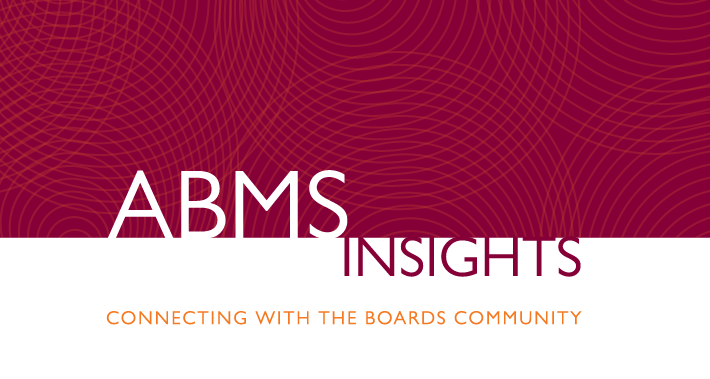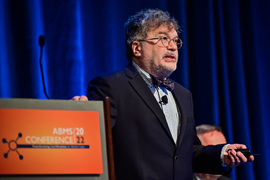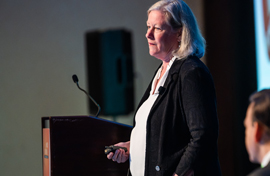
Regardless of who is spreading it or why, misinformation1 and disinformation2 about the risks, prevention, and treatment of COVID-19 has cost millions of lives and created distrust in the medical profession, according to speakers in the opening plenary of ABMS Conference 2022.

“Misinformation or disinformation is a deliberate, organized, and well-funded enterprise,” stated Peter Hotez, MD, PhD, Dean of the National School of Tropical Medicine; Professor of the Departments of Pediatrics, Molecular Virology & Microbiology, and Health Policy Scholar at Baylor College of Medicine; and Texas Children’s Hospital Endowed Chair of Tropical Pediatrics. “Understanding that is a first step toward helping to combat it,” he said.
Approximately 20 years ago, the anti-science ecosystem in the United States started with false claims that the measles, mumps, and rubella vaccine caused autism, in large part, due to a paper published in The Lancet that was later retracted. The scientific community began conducting large cohort studies showing that kids who received this vaccine were no more likely to acquire autism than kids who didn’t. The scientific community provided an explanation that autism begins in early fetal brain development long before kids ever get vaccines. As the father of a daughter with autism and intellectual disability, Dr. Hotez even wrote a book called Vaccines Did Not Cause Rachel’s Autism: My Journey as a Vaccine Scientist, Pediatrician, and Autism Dad explaining in depth why vaccines do not cause autism, and also the genetic and epigenetic basis of autism. For those efforts, he became a target of anti-vaccine activists and was even labeled “the OG villain.”
As the scientific community was gaining ground on the anti-vaccine activists, the latter began to “switch it up and move the goal posts,” he said. The anti-vaxxers cited specific ingredients in vaccines or too closely spaced vaccines as the cause of autism. Next, they moved to the human papillomavirus vaccine, even claiming that it caused autoimmunity and infertility, which was later assigned as a false claim to COVID-19 vaccines.
The Washington, D.C.-based Center for Countering Digital Hate has identified the “Disinformation Dozen,” 12 individuals responsible for generating about two-thirds of the vaccine misinformation on social media platforms. Some of the biggest instigators have monetized the internet by selling fake autism cures, nutritional supplements, and anti-vaccine conspiracy books, he said.
In 2014-15, a measles epidemic occurred in Southern California because so many children were not getting vaccinated. The California Legislature responded by eliminating all vaccine exemptions. This move created a backlash, to which the anti-vaccine groups reinvented themselves around the concept of health or medical freedom, Dr. Hotez said. This movement spread and Texas became the epicenter, as pediatric vaccine exemptions rose significantly. Over this period, the anti-vaccine movement became increasingly a political movement, emphasizing health freedom propaganda.
The COVID-19 vaccine became the next target. Anti-vaccine rhetoric is spewed nightly on media outlets imbued heavily with health freedom propaganda. In some cases, prominent elected officials refer to vaccinators as “medical brown shirts,” referring to clinicians who want populations to benefit from vaccinations. “They don’t just go after the science, they go after the scientists, namely Dr. Anthony Fauci. When they get tired of beating up on Tony, they go after me. I’m sort of ‘Fauci light’ for them,” quipped Dr. Hotez, who routinely receives hate email.
This movement has globalized, spreading to Canada and Western Europe. “When you go into Sub-Saharan African countries, you see U.S.-style anti-vaccine conspiracies,” Dr. Hotez said, adding, “We call it misinformation or disinformation, but I call it anti-science aggression and it’s a killer.”
More than 200,000 Americans have needlessly lost their lives out of defiance and allegiance to anti-science aggression. In Texas, more than 40 percent of COVID-19 deaths occurred after vaccines were widely available. In both Texas and nationally, vaccination rates fell along partisan lines; higher vaccination rates in the “blue” (Democratic) counties and low to no vaccination rates in the “red” (Republican) counties. Physicians and physician scientists are uncomfortable having these conversations because they are supposed to be politically neutral, he said.
The next battleground is all childhood vaccinations, he said. In Texas and other states, proposed legislation aims to stop all mandatory childhood vaccinations in schools.
Dr. Hotez believes that the anti-vaccine activism in the U.S. is going to reverse global vaccination goals. As Co-Director of the Texas Children’s Hospital Center for Vaccine Development, he helps develop vaccines for poverty-related diseases. About 10 years ago, the center began developing coronavirus vaccines. When COVID-19 hit, the center was able to develop a low-cost COVID-19 vaccine to promote global health. To date, 72 million doses of CORBEVAX have been administered. Recently, a second Halal vaccine known as INDOVAC was approved in Indonesia for Muslim majority countries. Dr. Hotez views this as great progress, but it will be in vain if anti-science aggression continues. He worries that the progress made during the last 20 years in reducing vaccine preventable diseases and neglected diseases has been halted and, in some cases, reversed.
“It’s not that we have an issue with conservative views, even extreme conservative views, but somehow we have to uncouple this defiance against medicine and science out of it, if there is any hope of saving lives,” Dr. Hotez concluded.
ABEM Acts to Protect Public
Teasing out the truth from COVID-19 misinformation and disinformation was a huge challenge, especially during the early days of the pandemic when information was being disseminated daily and changing just as rapidly, stated Marianne Gausche-Hill, MD, FACEP, FAAP, FAEMS, Medical Director of the Los Angeles County EMS Agency; Professor of Clinical Emergency Medicine and Pediatrics at the David Geffen School of Medicine at UCLA; and Clinical Faculty at Harbor-UCLA Medical Center in the Departments of Emergency Medicine and Pediatrics and Investigator at the Lundquist Institute at Harbor-UCLA.

The American Board of Emergency Medicine (ABEM) Board of Directors, of which Dr. Gausche-Hill was president last year, wrestled with issuing a statement about misinformation. As increasingly more ABEM certified physicians contacted the board about other emergency medicine (EM) physicians spreading disinformation either on social media or at in-person public gatherings, or those selling unproven COVID-19 treatments or mask exemptions online, ABEM decided to issue a statement.
Like other certifying boards, ABEM is viewed as an authority. It certifies approximately 93 percent of all practicing EM physicians in the U.S., and as such, has a responsibility to support EM physicians who were on the front lines risking their lives and those of their families every single day, she said, adding, “We have to hold ourselves to a higher standard.”
ABEM’s statement, issued in August 2021, states that “providing misleading and inaccurate information to the public can be sufficiently egregious and inconsistent with the ethical behavior of a physician who is expected to do no harm.” It further states that “making public statements that are directly contrary to prevailing medical evidence can constitute unprofessional conduct and may be subject to review by ABEM.” ABEM acted to protect the public and the value of the certificate, as well as to self-govern when physician conduct posed real-life consequences, Dr. Gausche-Hill said. The overwhelming response from EM physicians was positive.
The pandemic not only brought front and center issues related to the verity and dynamic nature of information, but also presented challenges to understanding the landscape of medical practice, the intersection of the ABMS Member Boards’ responsibility to practicing physicians and the public, and risk to patients by physician actions, she said.
Challenges facing the Member Boards included a lack of agreement about what professionalism is; something “they know when they see it,” Dr. Gausche-Hill noted. Second, recommendations from federal agencies were changing constantly as new data emerged. It was hard for the Member Boards to determine what was the standard and what was prevailing evidence. “Everybody was trying to make the best decision they could, at the time, based on the information that they knew,” she recalled. “And nobody got it perfect. But people took that to mean that either ‘you got it right or if you didn’t, you lied.’”
Once the vaccine came, 95 percent of all physicians in Los Angeles County got vaccinated; about 70 percent of nurses and paramedics did. That created tensions between discourse, misinformation, and public trust. At issue, was respecting physicians’ right to express their honestly held opinions and the desire to protect patients and the public from false information.
Dr. Gausche-Hill reviewed the steps ABEM takes when EM physicians are reported for disseminating misinformation/disinformation. The process includes an investigation and an opportunity for physicians to state their case. Among the issues that impact ABEM’s decision to take disciplinary action are how fake is the statement (and based on what type of data), does the physician acknowledge that the stated position may be controversial, does the physician use his/her authority as a board certified physician to justify his/her position, and what is the perceived or actual risk to the public? Actions against a physician’s certificate range from a cease-and-desist letter or reprimand, probation, and suspension to revocation. For Member Boards, it’s critical to create fair and transparent processes, including due process, and effectively communicate so that the physician understands the implications. To date, ABEM has taken some form of action against only 15 EM physicians out of a pool of 42,000 board certified EM physicians.
“Ultimately, we are all members of the community of medicine and want to do the best job possible,” Dr. Gausche-Hill concluded. “As we move forward, we need to continue to lean into these issues, and be vocal and active to combat those that ultimately can harm the public.”
Humayun Chaudhry, DO, MACP, President and Chief Executive Officer of the Federation of State Medical Boards (FSMB), shared the perspective of state medical boards regarding misinformation/disinformation. FSMB represents all 70 of the nation’s state and territorial medical licensing boards.
1 Misinformation is false information shared by people who do not intend to mislead others, as defined by the Centers for Disease Control and Prevention.
2 Disinformation is false information deliberately created and disseminated with malicious intent.
